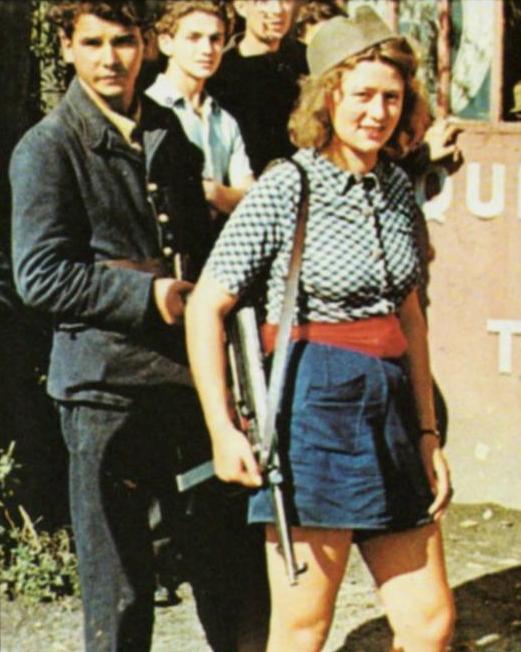
The Liberation of Paris: Partial Truce (August 20, 1944)

Figure 1.--Paris civilians becamne FFI fighters overnight. The FFI fought with a wide variety of small arms, anything they could get their hands on, including captured German weapons. Leave it to the French to add a bit of glmour to war. This female FFI fighter has a German MP-40 Schmeisser submachine gun. It was one of the best small arms of the War and prised by Allied soldiers who could get their hands on them. It could not be used effectively by the FFI because it used up amunition at a phenomenal rate and their was a desperate shortage of amunition after the first daybof fighting.
|
|
The Allies continued to drive north. The Americans enter Fontainbleau and diunally cross the Seine at Mantes. Général de Gaulle, flew from Cherbourg to General Eisenhower's headquaters at Mans to discuss the situation in Paris. Barricades o appeared throughout the city. FFI fighters unable to dislodge the Germans prepared for a seige. organized themselves to sustain a siege. Trucks were positioned to block the streets and restrict German tank movements. The FFI men cut down trees cut began digging trenches in the pavement to provide paving stones to strengrhen the the barricades. The general population joined in the effort, men, women, and children brought out wooden carts to move the building material. The FFI targeted fuel trucks. Tanks were a tough target, fuel tricks were not. And without fuel the tnks could not move. Some of the fuel trucks were captured. The FFI commndered civilian vehicles were commandeered, painted with camouflage or French colors and marked with the FFI emblem. The FFI used them to transport precious ammunition to the barricades and for communications. General Choltitz agreed to extend the truce with the FFI (August 20). It is unclear just what his thinking was at this point. Some sources say he was hoping to bring more troops into the city toquel the rebellion, but given the deteriorating military situation this does not make a lot of sense. Choltitz throughout had an extensive military record. He had proven himself to be a competent, brutal commander. But he was not aie-hard NAZI and he was a prefessionl militry commandde who could both read a map and was in command of his senses. Aftr fighting the Allies in Normandy, he ws well awre of heir military capavility. And German troops in the area were at this stage of the War was more intrested in getting back to the Reich than fighting to save maintain control of Paris for a few days. The more extreme FFI leaders, primarily the Communists, however, opposed to the truce--ignoring the ammunition situation. M. Raoul Nordling, the Swedish consul-general in Paris, incontact with both the FFI and Germans worked hard to maintain the truce. He also managed to save FFI fighters held by the Germans. The FFI occupied the Hôtel de Ville in the early morning. The CNR agreed to the cease-fire extension. The FFI is, however split. Colonel Lizé condemed all discussions with the Germans as an `act of treason'. Parodi is arrested. Loudspeaker trucks from the Préfecture de police in the afternoon announce the cease-fire. Flouret assumed his functions at the battered Préfecture de la Seine. Parodi was released during the night. COMAC issues a a memorandum against the cease-fire.
CIH -- WW II

Navigate the CIH World War II Section:
[Return to Main liberation of Paris fighting page]
[Return to Main liberation of Paris page]
[About Us]
[Biographies]
[Campaigns]
[Children]
[Countries]
[Deciding factors]
[Diplomacy]
[Geo-political crisis]
[Economics]
[Home front]
[Intelligence]
[POWs]
[Resistance]
[Race]
[Refugees]
[Technology]
[Totalitarian powers]
[Bibliographies]
[Contributions]
[FAQs]
[Images]
[Links]
[Registration]
[Tools]
[Return to Main World War II page]
[Return to Main war essay page]
[Return to CIH Home page]
Created: 8:29 PM 4/18/2015
Last updated: 8:29 PM 4/18/2015



